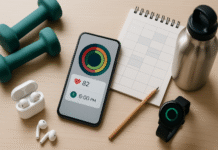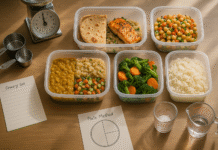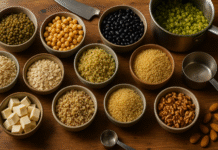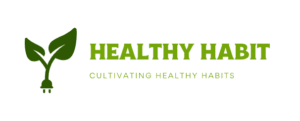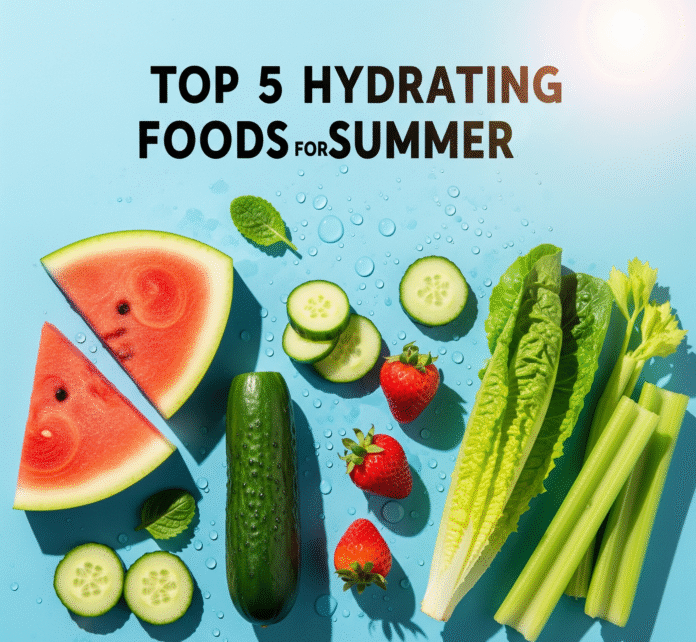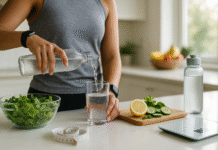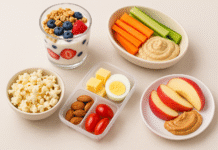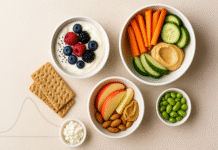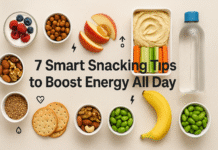Stay Hydrated This Summer: Your Ultimate Guide to Hydrating Foods
It’s really vital to drink enough water in the summer when it’s hot to keep your energy up, your brain working, and your body temperature in balance. Adding foods that keep you hydrated to your diet can help you stay hydrated, get key nutrients, and avoid feeling weary and sluggish when the weather gets hot. This complete guide, which is also helpful for search engines, will show you:
- Why you need to drink a lot of water in the summer
- How to pick foods that truly keep you hydrated
- A closer look at the five top superfoods that help you stay hydrated
- Simple recipes and ways to serve
- The greatest ways to keep things safe
- More ways to drink water
- Get expert help with common questions
Why It’s Necessary to Drink a Lot of Water in the Heat
We sweat and breathe more when it’s hot outside, which makes our bodies lose more water. If you’re dehydrated, even dropping 1% to 2% of your body weight can make things worse:
- Cognitive function and mood: hard to focus, headaches, and being irritable.
- Getting weary, cramped, and disoriented right away is a sign of poor physical performance.
- Poor digestion and detoxification can cause a slowed metabolism, constipation, and a buildup of pollutants.
The CDC says that drinking enough water helps you think, keeps your blood volume consistent, and keeps your body temperature stable when it’s hot. The Mayo Clinic also advises that many fruits and vegetables are made up of at least 80% water, so they are a terrific method to acquire the fluids you need every day.
How to Choose Foods That Really Keep You Hydrated
Not all “juicy” foods will help you keep hydrated. When you think about foods that keep you hydrated, think about:
- Water content: At least 90% of the weight should be water.
- Electrolyte profile: Sodium, potassium, and magnesium are present to assist keep fluids in the body.
- Vitamins A, C, and E are micronutrients that help cells operate better and protect them from heat stress.
- Low sodium: Don’t add salt to your food because it can throw off the balance of fluids in your body.
- Cut back on simple sugars to keep your blood sugar from increasing and your body from being dehydrated.
These criteria make sure that you’re not just “wetting” your tissues, but also giving your body the electrolytes and nutrients it loses when you sweat.
The Top 5 Superfoods for Hydration
1. Watermelon (Citrullus lanatus)
To sum up, watermelon is the best summer fruit since it is sweet, juicy, and has more than 92% water by weight. It not only satisfies your thirst, but it also has a lot of amino acids and antioxidants.
Nutritional Information (per cup, diced): 46 calories
- It is 92% water.
- Vitamin C: 21% of the daily value
- Beta-carotene is a vitamin A that has 18% DV.
- Potassium: 5% of the daily value
- Lycopene: 6,000 μg
The Best Things
- Power of hydration: Drinking a lot of water and a little potassium helps keep the body’s fluids in balance.
- Vitamin C and lycopene help fight free radicals that are generated when you get too hot.
- Citrulline from plants may help muscles repair by making them less sore after a workout.
How to Use:
- Take cubes out of the fridge and serve them cold in the middle of the afternoon to give yourself a boost.
- Add mint, lime juice, and ice to smoothies to make a cold slush.
- Add feta, cucumber, and balsamic vinegar to salads for a savory flavor.
How to Pick and Store Things
- When you tap a ripe melon, it should make a hollow sound and have a yellow “ground spot” that is even all over.
- You can keep whole melons at room temperature for up to ten days. If you put chopped melons in a container that won’t let air in, you can preserve them in the fridge for three to four days.
2. Cucumber (Cucumis sativus)
Summary: Cucumber is 96% water and has specific electrolytes that make it one of the best veggies for keeping you hydrated.
Nutrition Facts (for 1 cup, sliced): 16 calories
- Water: 96%
- 19% of the Daily Value for Vitamin K
- 4% of the DV for potassium
- 4% of the magnesium you need each day
Most Important Benefits
- It has more than 8 ounces of water in a cup, which is a lot.
- Skin health: Eating silica and antioxidants on a daily basis might make your skin look better.
- Low in calories, thus it’s ideal for losing weight and remaining hydrated.
How to Use:
- Cut up and add to pitchers of water to produce a drink that feels like a spa.
- Add Greek yogurt and dill to cold soups to make a creamy gazpacho.
- Wraps and rolls: Use thin slices of cucumber instead of tortillas to make sushi or wraps.
How to Choose and Keep
- Pick cucumbers that are dark green and hard, with no soft areas.
- How to store: Uncut cucumbers can stay fresh in the fridge for 5 to 7 days if you wrap them in paper towels to absorb up the moisture.
3. Strawberries (Fragaria × ananassa)
Strawberries are largely water (91%), but they also have a lot of fiber, vitamin C, and manganese.
Nutrition Facts (for every half cup): 49 calories
- Ninety-one percent water
- Vitamin C: 149% of the daily value
- 30% of the daily value of manganese
- 3 grams of fiber
Important Benefits
- One cup includes over 150% of your daily vitamin C, which is important for your immune system.
- Controlling blood sugar: Fiber slows down the absorption of glucose, which minimizes the chance of being dehydrated from sugar increases.
- Anthocyanins help the endothelium perform better, which is healthy for your heart and metabolism.
How to Use:
- Breakfast Bowls: Top yogurt or oatmeal with chia seeds and sliced strawberries.
- Put baby spinach, goat cheese, and walnuts in salads.
- Desserts: Mix strawberries together and freeze them to make healthy popsicles.
How to Choose and Keep
- Pick berries that are bright red and have green hulls that are still fresh.
- Don’t wash strawberries until you’re going to eat them. You can leave them on paper towels for up to three days without washing them.
4. Leafy Greens Like Romaine and Butter Lettuce
If you look at other forms of lettuce, such romaine and butterhead, you’ll see that they are more than 95% water. This means they help you stay hydrated without giving you a lot of extra calories.
Nutrition Facts (for 2 cups of shredded romaine): 17 calories
- 95% water
- 82% of the daily amount of vitamin A
- 116% of the daily amount of vitamin K
- 16% of the daily value of folate
The Main Advantages
- Taking a lot of vitamin K is excellent for your bones because it helps them absorb nutrients.
- Beta-carotene turns into vitamin A, which is good for your eyes and keeps them from getting macular degeneration.
- Not a lot of sugar or salt: This is ideal for staying hydrated without adding any sugars or salts.
How to Use:
- To form a salad basis, blend with other healthy vegetables and a mild vinaigrette.
- Wraps: Use huge leaves instead of bread to make burgers or tacos.
- Add a handful of them to your green smoothies to make them thicker and more hydrating.
How to Choose Things and Maintain Them
- Pick leaves that are bright and fresh and don’t have brown edges.
- Storage: You can keep it in airtight containers with paper towels for up to seven days after washing and drying it.
5. Celery (Apium graveolens)
In short, celery is largely water (95%), but it also has a lot of potassium and sodium, which are electrolytes.
Nutritional Information (per cup, chopped): 16 calories
- It is mostly made up of water.
- 37% of the daily amount of vitamin K
- 8% of the daily potassium value
- 1.6 grams of fiber
The Main Benefits
- Potassium and salt are natural electrolytes that assist muscles work and keep fluids in the body.
- Apigenin and other phytochemicals can aid with inflammation that happens when you get too hot.
- Fiber keeps things moving, which avoids constipation that arises when you don’t drink enough water.
How to Use:
- Fill the stalks with nut butter or cottage cheese for a snack.
- Juices: Put ginger and apple in your morning drink to give you energy.
- Soups and stews: Cut them up into broths to enhance flavor and keep you hydrated.
How to Pick and Keep Advice
- Choose stalks that are straight, sturdy, light green, and have new leaves.
- Wrap them in aluminum foil to keep them fresh. You can keep them in the fridge for up to two weeks.
More Ways to Stay Hydrated
Electrolyte Boosters and Infused Waters
- Add mint, berries, or citrus slices to simple water.
- If you’re going to be outside for a long time, take electrolyte pills with a little sugar.
Snacking Smart
- Mix foods that keep you hydrated with lean proteins, such turkey roll-ups with cucumber.
- Stay away from drinks with a lot of caffeine and alcohol because they make you lose more fluids.
Timing Is Very Important
- Drink a substantial glass of water (8 to 12 ounces) and a smoothie to start your day off right.
- Drink a lot of fluids slowly instead of all at once. This will make it easier for your body to absorb them.
Check Out the Color of Your Pee
- If your pee is a light straw color, you are properly hydrated. If your pee is darker, you need to consume extra fluids.
Frequently Asked Questions (FAQs)
1. Can I only eat items that keep me hydrated and not drink any water?
Foods that keep you hydrated can give you up to 20% of the fluids you need each day, but you should also drink water. You should drink at least 8 to 10 glasses of water every day. However, depending on how busy you are and how hot it is, you may need to drink more or less.
2. Do frozen fruits and veggies keep you just as hydrated as fresh ones?
Yes. Most of the water and nutrients stay in food when you freeze it. If you want to keep the texture from altering too much, let it thaw slowly in the fridge and consume it immediately away.
3. Do sports drinks hydrate you better than water?
Sports drinks with electrolytes and carbs can benefit you if you work out hard for more than an hour. If you do modest activity every day, all you need is plain water and snacks that keep you hydrated. This keeps you from receiving more sugar.
4. How can I keep foods that have a lot of water in them from going bad too quickly?
Keep them at the correct temperatures (32–40°F/0–4°C), use packaging that lets air in (such perforated bags), and only wash them before you eat. Put the older things in your fridge near the front.
5. Do canned fruits and veggies help you drink enough water?
Fruits and vegetables that come in cans often have extra sugars or salts added to them. This can make you less thirsty. Rinsing canned hummus and vegetables under water can help lessen the amount of salt in them, but fresh or frozen is better.
The End
Eating foods containing a lot of water, such watermelon, cucumber, strawberries, leafy greens, and celery, is a fantastic way to stay hydrated, acquire key vitamins and minerals, and keep your energy up when the weather becomes hot. By choosing fresh, nutrient-rich meals, storing them correctly, and drinking them in a wise way, you may stay healthy, do well, and feel good all season long.
It’s important to remember that drinking enough water is both an art and a science. It includes eating correctly, drinking enough water, and keeping your electrolytes in check. Use the recipes and suggestions to enjoy these five foods that keep you hydrated all summer long.
References
- Centers for Disease Control and Prevention. Nutrition & Hydration. https://www.cdc.gov/healthywater/drinking/nutrition/index.html
- Mayo Clinic. Water: How much should you drink every day? https://www.mayoclinic.org/healthy-lifestyle/nutrition-and-healthy-eating/in-depth/water/art-20044256
- Harvard T.H. Chan School of Public Health. Watermelon. https://www.hsph.harvard.edu/nutritionsource/food-features/watermelon/
- Journal of the International Society of Sports Nutrition. “Citrulline Malate Supplementation and Exercise Performance.” https://jissn.biomedcentral.com/articles/10.1186/1550-2783-11-20
- StillTasty. Watermelon Storage Tips. https://www.stilltasty.com/fooditems/index/18319
- National Institutes of Health, National Center for Complementary and Integrative Health. Silicon in the Diet. https://www.ncbi.nlm.nih.gov/pmc/articles/PMC3789923/
- American Heart Association. Berry Anthocyanins and Cardiovascular Health. https://www.ahajournals.org/doi/10.1161/CIRCULATIONAHA.116.022356
- Office of Dietary Supplements, NIH. Vitamin K Fact Sheet for Consumers. https://ods.od.nih.gov/factsheets/VitaminK-Consumer/
- Journal of Food Science and Technology. “Anti‑Inflammatory Effects of Celery Phytochemicals.” https://www.ncbi.nlm.nih.gov/pmc/articles/PMC5302184/
- National Academies of Sciences, Engineering, and Medicine. Dietary Reference Intakes for Water. https://www.nationalacademies.org/nutrition/drinking-water-and-healthy-beverages




